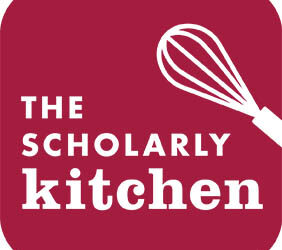Once a week over the last six months, I hooked up my microphone, tuned my radio voice, and twisted the arm of a publishing executive to talk to me about their work. Ever since becoming co-host of the Scholarly Communication Podcast on the New Books Network in early 2022, I have used the show as a platform to learn more about the scholarly publishing industry (to satisfy my self-diagnosed ‘Curious George’ complex), do deep dives with industry leaders (who I likely would not have had access to otherwise), develop informed business strategy, and understand not only how the university publishing business has evolved but also what direction it is going in the future. The interviewees were mainly representatives of university publishers with a smattering of small to mid-size commercial book publishers sprinkled in as well.
My first surprise was that many of the directors I spoke with never had been interviewed on a podcast before and weren’t always comfortable talking about their craft. I had expected these folks to all be extroverts with years of sales and marketing experience, but that wasn’t always the case. Regardless, the interviewees braved the uncharted waters to discuss subjects they felt passionate about, leading to interviews that were both engaging and lively. Amazingly, the overlap between different interviews was minimal and each director shed new light on a different aspect of the industry.
It is worth noting, that I approached this project as an outsider (never having held a position with a publisher) and probably missed some important nuances that a career publishing professional could easily fill in (that’s what the comments section is for 😉). Some of the points below may be obvious to industry insiders but I chose to share the following observations based on their being surprising, compelling, or disturbing to me, or a combination of all three. Any mistakes or misrepresentations of the industry are entirely mine.

-
There is no consensus sustainable model for OA book publishing yet
I heard about a number of different initiatives around OA book publishing from BPC’s (book publishing charges) and institutional crowdfunding, to ‘Subscribe to Open’, ‘Path to Open’ or even ‘Flip to Open‘. In truth, at times I found all of the different ‘to Open’ models hard to track, an issue that I imagine authors might identify with. However, I did detect a general theme of optimism relating to a move away from the author as payer model and towards the voluntary library contribution model. These models seem to rely on a high degree of trust and altruism and the assumption that libraries will keep their budgets when the dust settles on transformative agreements. It also presumes that the larger libraries will take on a big (maybe even disproportionate?) role supporting the smaller ones.
-
University scholarly publishers suffer from the reputation of academic publishers regardless of their specific business model or terms
Academic publishers find themselves trying to break free of the general reputation of scholarly publishers as profit-driven, money-grabbing, shareholder-butt-kissers. It takes a lot of tedious author education for these publishers to explain why this is not the case and how they different. Even if they can do this successfully, they still need to continually explain to authors why they receive such small royalties, or why books are so expensive for their colleagues or students to purchase.
-
Many university publishers aren’t self-sustaining and rely heavily on their parent institutions for funding
University publishers have different arrangements with their parent institutions, from being connected in name only to running all of their operations through the university. In any case, many university publishers are not profitable and are left with no choice but to have some level of dependance on their parent institutions. This means that these publishers need to justify their activities (and even existence) relative to all of the other university priorities. In a world where student satisfaction and experience rule the day, it is unclear where university publishing fits in the budget pecking order. In addition, there is often a mismatch between the areas of interest of the publisher and those of the home institution. I was surprised to learn that many university presses focus on topics that the parent institution has no interest in or connection to whatsoever.
-
Confusion around publishing priorities
Publishers have competing priorities in terms of what to publish and often struggle to find a balance between publishing work from their home institution or about their local, historical focus while simultaneously opening their doors to a wider range of scholars in an attempt to increase diversity of both authors and readers from around the world. Most publishers have a written stated commitment to DEI efforts and initiatives but that doesn’t always mean they know how to connect and communicate with those authors, or that they can easily move beyond from the base audiences they were created to serve or that provide a foundation for sales. For example, most publishers still struggle to publish from community colleges or scholars from outside of their geographic locale.
-
Amazon has transformed the sales landscape…and not for the better
If ten years ago, publishers sold most of their books to libraries and book stores, today Amazon leads sales by a large margin. Some publishers do more than half of their total sales on Amazon, making them quite vulnerable and susceptible to the algorithmic tweaks of the commercial behemoth. To make things worse, the vast majority of publishers have no direct line of communication with Amazon, so there is no way to negotiate better terms and conditions or report issues. This has had far reaching implications including the type of content (more trade titles) that these publishers now prioritize (see more on this below). It has also led to publishers increasingly relying on strength of ‘author platform’ in making acceptance decisions. The silver lining is that many publishers have developed important competencies in making research more accessible to the general public and packaging it in a way that can be easily accessed and consumed by larger and more diverse audiences.
-
There is a misalignment between publishers looking for trade books and academics’ need for more traditional monographs
Many of the major university publishers (Harvard, Columbia, and NYU to name a few) have made a sharp pivot towards trade titles and away from the traditional academic monograph over the last decade. In an ironic twist, commercial publishers tend to publish drier, niche titles while the university publishers take on more popular work, hoping to find a diamond-in-the-rough best seller. Many university publishers use their trade sales to support their more traditional, but less profitable, academic publishing efforts. This creates a lot of confusion for authors who expect the university brands will be more in line with the work and style of journal articles coming from research happening in the halls of academia.
-
Many publishers see list growth as the primary driver of Profit & Loss improvement
One publishing director told me that their financial goal was to ‘lose as little money as possible’, knowing that even breaking even was a bit of a pipe dream. In order to accomplish this goal, many publishers feel pressure to continually grow their lists. While the rate of growth is not as fast as in the commercial sector, there are questions about how quantity-driven approaches may impact the quality of the manuscripts. This also exacerbates issues relating to commissioning peer review (if you think it is hard finding a reviewer for an article, try a full book). To their credit, many of the directors I spoke with reinforced their commitment to a quality-first approach.
-
The difference between STM book publishing and HSS publishing is day and night
Publishing a book in the Humanities is still a primary means for recognition and career advancement for the author, while in STM it is often perceived as a waste of time. Social sciences fall somewhere in the middle, with certain fields lending themselves more to book publishing than others. As a result, despite the resources poured into STM publishing, university publishers in the sciences are hard to come by and the few that exist need to work twice as hard to get manuscripts while their HSS colleagues are flooded with too many submissions. On the commercial side, STM book publishing oftentimes looks a lot like an extension of journal publishing or ‘journal bundling’. The bottom line is that decisions regarding the content form of publication are made almost exclusively as the result of external financial considerations and factor and not based on the most appropriate forum for the spread of information in the respective context.
-
Books seem to have been left out of transformative agreements
For starters, university and small to mid-size commercial publishers don’t wield the size and influence to negotiate the large-scale transformative agreements that the big publishers do. In addition, books are generally an afterthought of these negotiations (or left out entirely) leading to a situation whereby the budgets for these projects may end up becoming the scraps after the dust of the transformative negotiations settle. This may lead to eventual consolidation as Roger Schonfeld recently suggested.
-
Publishers are struggling to figure out how they can add value to authors while being squeezed to go leaner
In a digital age with an ever-declining sales market, publishers are being forced to constantly examine what their real value adds are and to ask themselves which services they provide are critical and which are more “nice to have”. Many of those services are already being outsourced to third-party companies and publishers act as a kind of contractor or project manager bringing things together. For example, some publishers still edit quite heavily internally, while others have outsourced the editing workflow entirely. It will be interesting to see in what ways publishers reimagine and adapt their value proposition in light of these trends.
Thank you to all of the interviewees who took the time to take part and be interviewed (listed in order of recording date).
Gita Manaktala, MIT Press
Think Bigger–How Researchers Can Use their Books to Make Real Breakthroughs
Jennifer Crewe, Columbia University Press
The Art of Translating Academic Research
Eric Schwartz, Columbia University Press
From Manufacturing Floor to University Press Editorial Director
Ben Denne, Cambridge University Press
Making Open Access Work for Both Readers and Authors
Alan Harvey, Stamford University Press
Profitability and University Press Publishing
Irene Van Rossom, Amsterdam University Press
Open Access in Humanities Publishing
Tiffany Gasbarrini, Johns Hopkins University Press
Sally Wilson, Emerald
The Challenge of AI to Publishing
Alessandra Anzani, Academic Studies Press
The Many Kinds of Editing it Takes to Bring a Book to Print
Vivian Beghahnn, Berghann Books
Discussion
6 Thoughts on "10 Trends I Observed Interviewing 10 Publishing Executives About the Future of Academic Books"
Thank you for your podcast, Avi, and for your focus on book publishing. I’ve really enjoyed these interviews and I find your observations above really resonate. University of Michigan Press is responsible for yet another “open” acronym (Fund to Mission) and is one of 30+ publishers in another one (Path to Open). From the author’s perspective, I think we can make the experience pretty seamless. “Do you want an OA version of your ebook? Yes? Well, you can have one without payment.” Unsurprisingly, 75% of authors say “yes, please.”
Wait, only 75%? Why are 25%% turning it down?
The acquiring editors have heard all sorts of reasons, Lisa: Third party image permissions issues, conservative tenure committees worried about “reputation of OA,” concerns about undermining perceived sales-potential of what the author sees as a “crossover trade book”, fear of undermining the potential for subsidiary rights sales, worries that OA will lead to their work being plagiarized . . . it’s a bundle of different issues. Some are resolved quickly by a delayed OA model like Path to Open (“it’s OK, you’ll have tenure (or not) by the time it goes OA”), others need longer term solutions like encouraging rights licensing agencies to accept academic exemptions or institutional attorneys to be more comfortable with fair use claims.
Thanks for these details. It’s a good reminder that publishers are sometimes ahead of their authors!
This Cambridge professor at the DOI below believes more in ‘legacy’ book publishing than OA books, and regrets their slow disappearance, forced by funding and institutional shifts in the UK. And yet most Uni Presses are transitioning pretty fast out of conventional books, like MIT (US) and UCL (in UK). We are composing a response to the article since the argument seems flawed.
I also think ‘conservative tenure committees’ might be a North American thing – amazing how they persist, even in radical humanities fields. How long are they going to remain conservative and prefer a ‘a book’ from one of five or so expensive US University Presses, in a decolonising world? Perhaps only until the current crop of senior scholars retire. https://rgs-ibg.onlinelibrary.wiley.com/doi/10.1111/area.12877
Thanks Charles, I am happy to hear that these topics seem to be top of mind for insiders like yourself. That is indeed fascinating that authors might not choose OA even if it is entirely free. It makes me rethink whether the main issue here is one of branding as I posited in my post or more pragmatic concerns that you raise here. I wonder if other UP’s have had similar experiences with author adoption.



